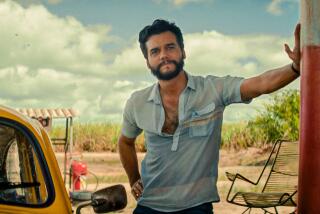ON LOCATION : We Thought Hollywood Liked Guns : ‘Death and the Maiden’ was a hot ticket on Broadway. But when it came time to make the movie, there were no takers in the States. But European investors came through, and Roman Polanski is directing it in Paris
- Share via
PARIS — Ben Kingsley sits uncomfortably in a stiff chair, hands tied behind his back, movie blood streaming down his shaved head. Pointed at his head is a gun held by Sigourney Weaver, a look of satisfaction on her face.
Suddenly, someone cinches the rope tighter around Kingsley’s wrists.
“Hey, those hands aren’t props,” he complains.
Roman Polanski looks up from behind the chair, where he has been kneeling to retie the rope. “Sorry, Ben,” the director says, with concern.
“Oh,” says Kingsley, softening in surprise. “Hello, guv’ner.” Turning to Weaver, Kingsley confides with a wry smile: “Say goodby to my circulation. Roman’s doing it.”
On the set of “Death and the Maiden,” the film version of Ariel Dorfman’s successful play, Roman Polanski seems to be everywhere. Tying Kingsley’s hands. Adjusting a light bulb. Helping Weaver with a tape recorder. Demanding “just one more” rehearsal. Even firing a starter’s pistol, which echoes loudly on the Paris sound stage, to energize his actors.
“You see, we have blood here,” Polanski tells the crew at one point, explaining his request for another rehearsal before the cameras roll. “Everything has to function like a Swiss watch.”
As Weaver observes: “Roman pays great attention to malevolent detail.”
“He’s marvelous,” Kingsley adds later, smoking a cigarette in his dressing room. “I love the way he watches. Imagine a child learning to swim. When the child looks up, he wants to see his parents watching. Roman is like that parent. He never looks away. And that makes an actor feel he can freely create and be spontaneous.”
“Death and the Maiden” has been staged in 47 countries and nearly every major American city since it opened in London in 1991. The Broadway production earned Glenn Close, who starred with Gene Hackman and Richard Dreyfuss, a Tony Award. (Reviews of the West Coast premiere, at the San Diego Repertory Theatre in May 1993, and of the Mark Taper Forum production five months ago, were decidedly cooler than those on the East Coast.)
*
Now, for the big screen, it has two big-name stars in Weaver and Kingsley and one of the film world’s most gifted directors in Polanski. Fine Line will distribute it in the United States, and it is scheduled for release later this year. And yet, the play’s route to the sound stage at Studios de Boulogne in Paris has been anything but easy.
“It’s safe to say it was just about impossible to get this movie made,” says Thom Mount, the film’s producer.
Mount had produced the play on Broadway with Bonnie Timmerman, also a co-producer on the movie. But when he searched for financing in the United States, first with a cast of Anjelica Huston, Liam Neeson and Stephen Rea and later with the current cast, he came up empty-handed.
The producers eventually found the $10 million needed to make the picture from an assortment of European investors, a task made easier by Sigourney Weaver’s strong appeal overseas.
“I’ve never been on a movie that was more difficult to raise money for,” Mount says.
One reason was the material, which is dark, ambiguous and political. It tells the story of a woman, Paulina Escobar, an anti-government activist in an unnamed Latin American country, who had been kidnaped and tortured 15 years earlier by the military regime. The country’s new president has selected Paulina’s husband, Gerardo, a lawyer, to head a commission investigating killings by the previous regime.
On his way home from consultations with the new president, Gerardo has a flat tire and is given a helping hand by a doctor, Roberto Miranda. Paulina becomes convinced that the doctor is the man who had tortured her night after night as she lay blindfolded those many years before. To her husband’s dismay, she kidnaps the doctor at gunpoint and puts him on trial in their home.
The play takes place in one house with three actors, beginning late one night and concluding at dawn the next day. The screenplay by Dorfman and Rafael Yglesias, who wrote the screenplay for “Fearless” based on his novel, maintains much of that claustrophobic feeling, at Polanski’s insistence. There are still just three actors, no flashbacks, no extra characters and the filming is being done in sequence.
*
For Polanski, the physical limitations of the play and the subtlety of its message are part of its challenge.
“For Ariel (Dorfman), the most interesting thing was the problem of reconciliation after a dictatorship,” said the director, whose many credits include “Frantic,” “Rosemary’s Baby” and the recent “Bitter Moon.”
“But the relativity of truth is something I have always found fascinating,” he said. “And I’ve always found torture profoundly revolting, since my earliest childhood in occupied Poland. I could never understand how man could do that to another man.”
But that doesn’t mean the film will be too dark for audiences. Quite the contrary, he says.
“Audiences go for entertainment,” he said. “It can be simple adventure, it can be human, it can be emotions. People don’t go to the cinema to learn anything. That has to be the icing on the cake.
“This film has suspense. It is a courtroom drama, and they always work--it’s a genre that everybody loves.”
And Polanski believes this psychological thriller, with the deep nuances that made it such a hit on stage, will tap renewed interest in what he calls “adult films,” such as “Schindler’s List,” “Philadelphia” and “In the Name of the Father.”
“Suddenly, filmmakers are making films about serious things,” Polanski says during a break in the 12-week shoot, which ended last month. “We’re using the same means of production, but we are turning out movies that are stronger. It just shows that well-made movies about the Jewish ghetto in Poland are much more interesting than well-made movies about dinosaurs.”
For the actors, the roles are meaty and intense.
“All I ask of a role is that it requires a certain degree of intelligent stimulation of the imagination,” says Kingsley, who plays the alleged torturer, Miranda. “This fits it perfectly.”
Weaver says the role of Paulina “is so dense, so rich, so difficult. I’m drawn to women who are isolated and then burst out of that isolation. And Paulina certainly does that. As an actor, you have a sense of having your mast at full sail here. I’m going to be pretty spoiled after this film.”
“To be practical,” says Stuart Wilson, the British actor who plays her husband, Gerardo, “it’s a wonderful three-hander. . . .”
*
“Death and the Maiden” is, at its core, a whodunit. Is Dr. Miranda the man who Paulina claims he is? But it also contains a dilemma. If Miranda is, in fact, the man who tortured Paulina, does she have the moral right to use the same tactics against him?
“Can you deal with your oppressor the same way the oppressor dealt with you?” Polanski says, posing one of the central questions of the film. “Does the demand for retribution give you license to use their methods? I think not, although you can’t blame a person for spontaneously reacting.”
Paulina’s husband, Gerardo, is torn by that question as well.
“He is a guiding light for the audience,” said Wilson. “He mirrors the ambiguity in the piece.”
Polanski, Dorfman and producer Mount were more than happy to do their film without the strings that so often come with money from Hollywood. Mount produced Polanski’s thriller “Frantic,” and the pair well remember losing their battle with the studio to keep the original ending.
“This is a very disturbing story,” says Dorfman, in a telephone interview from Rome, where the play opened recently. “There is a tendency in Hollywood to say we have to go for infantile or puerile emotions. So there is a fear that people will not go to see this. I think that is totally wrong.”
Polanski was Dorfman’s choice as director.
“I was looking for someone who could find the exact line between the commercial and the artistic. Not many people can do that,” says the Chilean-born Dorfman, who went into self-imposed exile during the regime of dictator Gen. Augusto Pinochet and now teaches literature and Latin America studies at Duke University in Durham, N.C.
“But Polanski is a strange mixture. He understands the perversion in the world, but he also has this childlike innocence. I love that combination.”
Under Polanski, “Death and the Maiden” closely follows the play, with all the interior scenes shot in one beach house built on the sound stage by Academy Award-winning production designer Pierre Guffroy.
“Great filmmaking comes from an aggressive, completely personal vision,” Mount says. “Roman has that. No one understands menace within a confined space better than Roman Polanski. He finds astonishing subtlety in the treachery of the ordinary.”
*
On the set recently, Polanski wears black jeans, with a hole in one knee, and a black leather jacket over a white T-shirt. The three actors and the small crew lean on every word he utters, in French or in English.
“Roman doesn’t say much, but what he does tell you is gold,” Weaver says. “He wants to open Pandora’s Box. He doesn’t look for anything pat and he really gets the juice out.”
Adds Wilson: “I’ve learned to shut up and listen a lot more. Roman makes extremely interesting dramatic choices--things you couldn’t have thought of.”
Back on the set, with Kingsley’s hands tied to his satisfaction, Polanski calls again for “action.” After the scene, he pronounces: “Print. Beautiful. That’s it. Merci.”
But then he pauses. “I’d like to do one more,” he says finally, “with the whole thing a lot faster.”
Five takes later, the scene is in the can.
Smiling, Polanski says, “Sometimes it’s worth it.”*
More to Read
The biggest entertainment stories
Get our big stories about Hollywood, film, television, music, arts, culture and more right in your inbox as soon as they publish.
You may occasionally receive promotional content from the Los Angeles Times.











